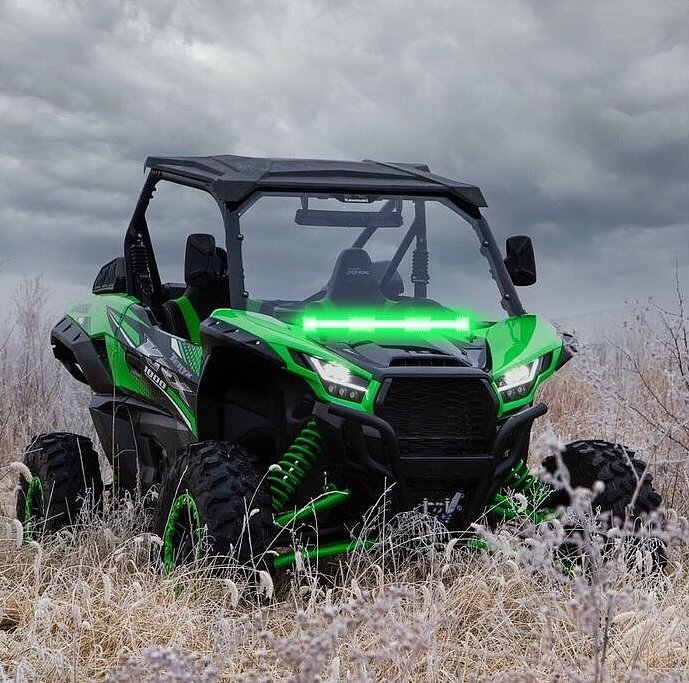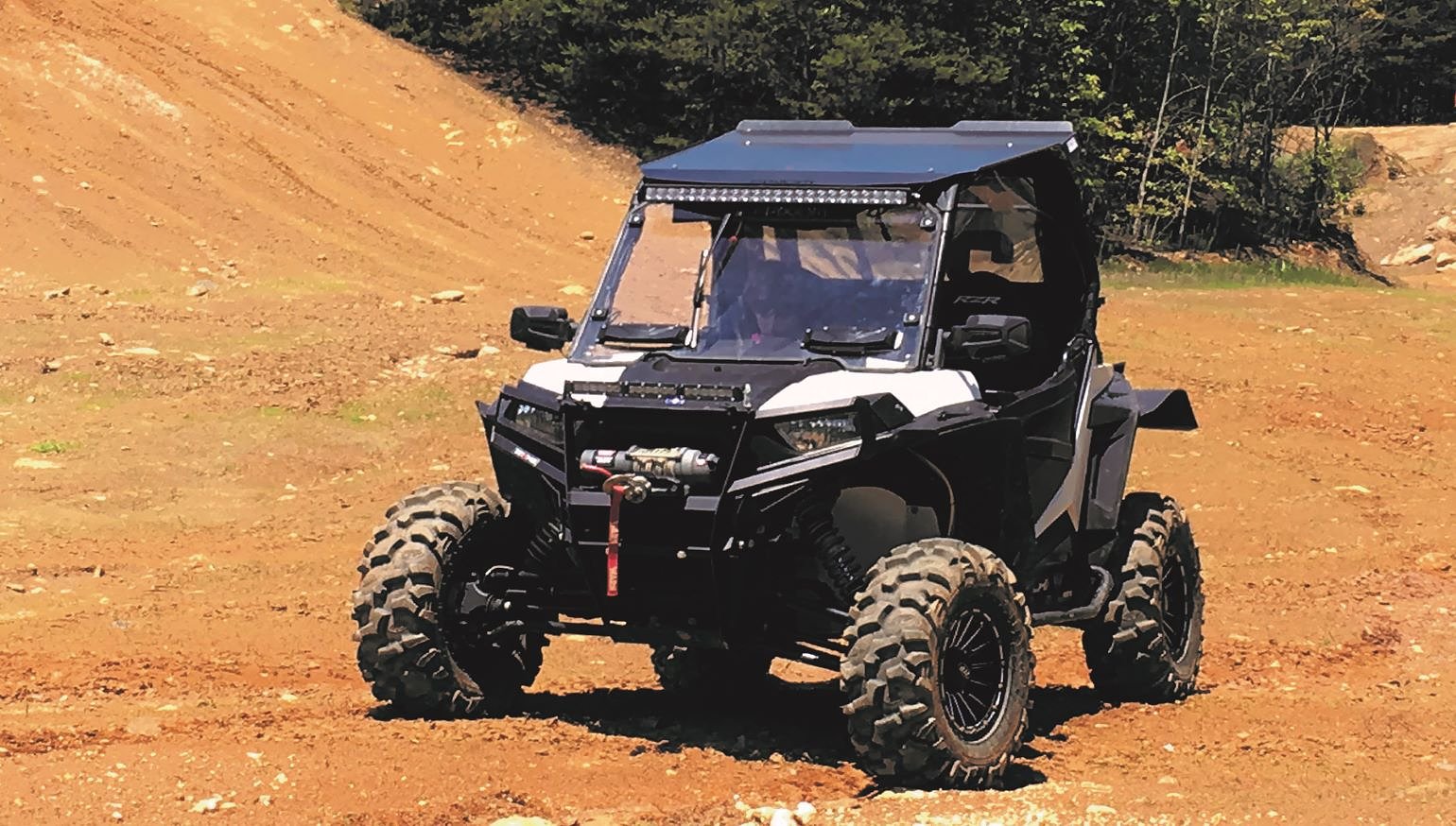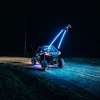You just purchased a new side-by-side and before the sheen is worn off the tires you’re already thinking about how to make it more capable than showroom stock. There are many modifications on the market to choose from, but one that's popular and useful is added lighting.
It’s easy to get carried away on a long ride and get caught in the dark on the way back to camp or trailhead. Good lighting is cheap insurance against injuries, vehicle repair bills or unplanned overnight stays when you get stuck in a hole you couldn't see in the dark.
Aftermarket lighting options are as varied as the riders who buy them. Before buying a lighting system consider how you use your vehicle and what you want out of your new gear.
Four factors to consider when choosing lighting
Whether you choose light bars, pods or a combination of the two, you also need to decide which areas around the vehicle need to be illuminated, how much power draw your electrical system can support, the type of lighting element to suit your needs and the desired light color.

Spotlights provide a long throw, illuminating a greater distance, flood lights cover the mid areas, and diffused lights cast a short but wide coverage area. A desert racer who pins the throttle on late-night trails needs a farther reaching, focused setup to keep from outrunning their light. A rancher might want flood lights mounted on all sides of their UTV to illuminate a 360-degree workspace in a pre-dawn pasture. Different vehicles also offer varying mounting options.
There’s limited real estate on an ATV, but a four-passenger UTV’s long roll cage can mount enough lights to rival a late 1970s Pink Floyd concert. However, just because you can mount all those lights doesn’t mean your rig’s charging system can support the power draw.
ATVs and side by sides use stators to charge the vehicle’s battery and power all the stock electronics and electric accessories. Typically, all the factory equipment will use about two thirds of the charging system’s power output when all accessories are used at the same time.
The factory service manual lists the output of a machine’s charging system. Full-size UTVs typically carry stators with anywhere from 500 to 700 watts at maximum output. Some larger lights can pull almost half that power on their own, like the 42 inch Dual Row Extreme LED Light Bar from DragonFire which draws 240 watts.
An overloaded charging system can’t keep up with demand and the battery will die, sometimes quickly and at an inopportune moment. Aftermarket stators with higher output are available but can run thousands of dollars after installation. A cheaper way to boost power reserves is purchasing a larger battery or adding a second unit. An overloaded charging system still won’t be able to keep up and the batteries will still drain, but it will take longer for them to go dead. Attaching a trickle charger for off days complements these types of setups. But the best option is to determine the ouput of your charging system, check how much power your accessory lights draw, and make sure your machine can power it all.

The type of lighting element plays a major role in determining how power-hungry a lighting system is. Halogen bulbs rule the showroom floor, but not only do they use more juice than aftermarket options like LEDs, but they’re also not as bright. High-intensity diode bulbs are much brighter than the factory halogens and they have a lower power draw, but they still use more energy than equivalent LEDs.
Light temperature is another consideration when choosing lighting for your off-roader. The temperature determines the color spectrum of the beam. Measured in Kelvin, light appears warmer and more yellow on the low end of the scale and as the temperature increases turns to a brighter white and has a blue hue on the top end.
White light improves visibility, but some riders prefer lower temperature lights because they’re easier on the eyes for both the operator and anyone watching them approach. Many lights also offer customizable red, blue, and green spectrum options, usually more for fun than function.
With these factors considered, it’s time to look at the lighting solutions available for your rig.
Light bars for ATVs and side-by-sides
Light bars are far from new in the off-road scene but they’ve evolved from the traditional set of round halogens to tightly packed LEDs capable of turning midnight into noon. Desert racers rely on their capability to avoid disaster while bombing courses through the night and ranchers illuminate whole sections of irrigation legs when repair jobs stretch past dusk.
They’re a versatile option and come in more flavors than the taps at the local watering hole. Compact bars measure just a few inches long with a single row of lights to fit tight spaces. When space isn’t a priority, there are bars to fill the full width of a side by side with stacked rows of LEDs combining spot and flood lights to cover the most trail possible.
A stand-alone bar for a specific purpose can fill some users' needs with a laser focus, such as the 2-in-1 Light Bar from XKGLOW intended for hunters and fishermen who want a green light option to keep a low profile when pursuing their quarry. Where legal, a green light can highlight the eyes of varmints, wild hogs, frogs and other game without spooking them as much as white light could.

But some folks operate in a wide range of terrain and conditions or simply don’t know how their machine will be used yet. For these cases there are Swiss Army knife options that combine light patterns and intensity modes into one package.
Quad Boss builds their DRL Light Bar with spot and flood lights for more complete trail coverage and in daylight hours it can drop intensity to function as a daytime driving light or DRL. A DRL offers an extra layer of safety by upping visibility to oncoming traffic or pedestrians without blinding onlookers. As an added bonus the bar consumes less energy when in DRL mode.
Light pods
Pods fit in tight spaces and complement light bars or boost visibility when the coverage of a bar isn’t necessary. The small size of the lights lends itself to many mounting locations and they can be found on grill guards, cargo racks, and often mounted to the A-pillars of UTV roll cages.
Pods can be arranged in a wide range of combinations of spot, flood and diffused lights mounted in different locations. Spotlights work best mounted high to get maximum reach and can be mounted further to the rear of the vehicle without limiting the beam. Floods and diffused lights work well mounted lower but are more visible down trail if the pods are used as DRLs.
Pod lights can be purchased individually but multi-light kits like the two-pod offering from Rigid are more convenient and easier to wire together when more than one light pod is needed. The kit comes with mounting brackets, a wiring harness, a switch and electrical connectors to streamline installation and eliminate concerns about compatibility.
Light bars and pods are the most common lighting upgrades, but some applications call for parts that don’t fit neatly into those categories. Often they are a variation of those two basic designs but with niche features. For example, a dedicated crawling machine can benefit from “rock lights.” These small pod lights can be mounted around the undercarriage to illuminate the area immediately surrounding a crawler.
Whip It’s RGB Rock Light Kit is a popular choice due to its ease of installation and the kit’s completeness. It comes in four- and eight-light configurations to accommodate vehicles of different lengths and Whip It claims the system has 16 million configuration options controlled from a smartphone app. Riders can custom-mix colors for a Fast and Furious underglow effect and the lights can sync with your music for rock-crawling raves.
Whip lights
Riders who hit the sand dunes know that a flag can keep your ATV or side-by-side from ending up underneath someone else’s off-roader that may be twice the size of your vehicle. Safety flags aren’t sexy accessories and people don’t generally get excited about mounting them to a vehicle they’ve spent thousands of dollars to make pleasing to the eye. But it’s 2022 and we have space age options that will make your UTV look more like a UFO.
Whip lights stick straight up from the back of a vehicle with LEDs strung along a long rod. Safety flagging is a legal requirement in some locales but whip lights are growing in popularity even where not mandated. They provide higher visibility than traditional flags but don’t look like they belong to the last century.
Whips help other riders identify a slow mover on a forested trail or a stuck machine in a mud bog but are often added as a style element. Some options, like the RF Lighted Whip from Whip It, allow users to customize the rod’s appearance with dozens of color options and can also switch between strobe, flash and fade light patterns, all from a remote.
Notably, this whip is available in lengths from three to seven feet and in white and black versions, so even when the sun is high it will match the ride it’s attached to. The rod is spring mounted to avoid damage when riding in tight spaces. The flag can be removed when unnecessary and the entire unit is on a quick detach mount for easy removal.
A properly selected lighting system will keep you and the road ahead visible whether you choose whips, pods, light bars, or combine all three to emulate every kid’s favorite neighbor during the holidays. They’re a more responsible but equally fun way to “light em up.”










